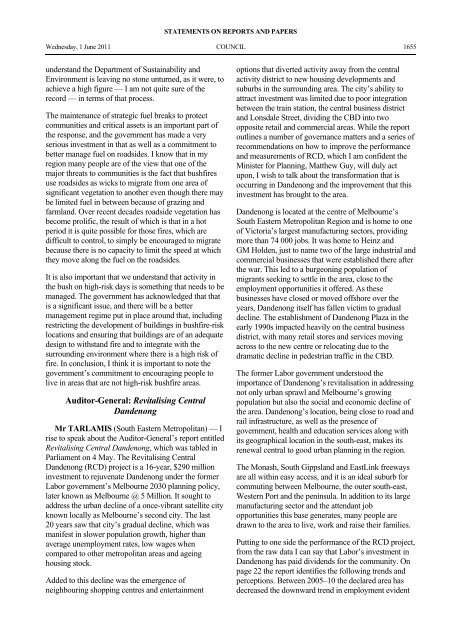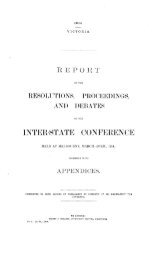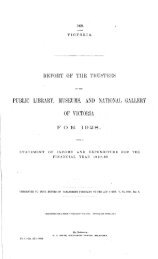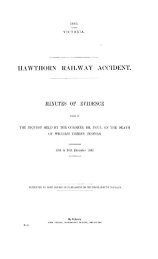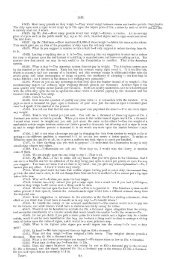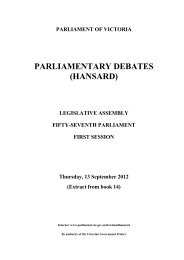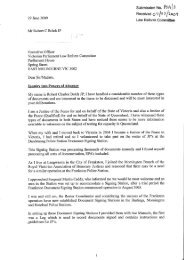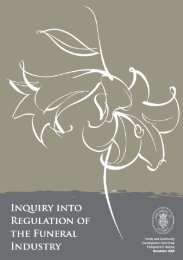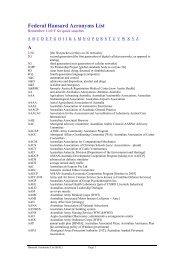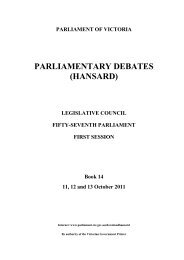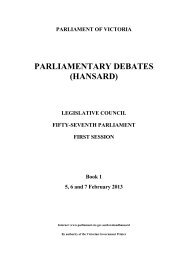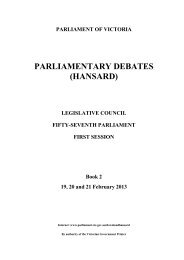Book 8 - Parliament of Victoria
Book 8 - Parliament of Victoria
Book 8 - Parliament of Victoria
You also want an ePaper? Increase the reach of your titles
YUMPU automatically turns print PDFs into web optimized ePapers that Google loves.
STATEMENTS ON REPORTS AND PAPERS<br />
Wednesday, 1 June 2011 COUNCIL 1655<br />
understand the Department <strong>of</strong> Sustainability and<br />
Environment is leaving no stone unturned, as it were, to<br />
achieve a high figure — I am not quite sure <strong>of</strong> the<br />
record — in terms <strong>of</strong> that process.<br />
The maintenance <strong>of</strong> strategic fuel breaks to protect<br />
communities and critical assets is an important part <strong>of</strong><br />
the response, and the government has made a very<br />
serious investment in that as well as a commitment to<br />
better manage fuel on roadsides. I know that in my<br />
region many people are <strong>of</strong> the view that one <strong>of</strong> the<br />
major threats to communities is the fact that bushfires<br />
use roadsides as wicks to migrate from one area <strong>of</strong><br />
significant vegetation to another even though there may<br />
be limited fuel in between because <strong>of</strong> grazing and<br />
farmland. Over recent decades roadside vegetation has<br />
become prolific, the result <strong>of</strong> which is that in a hot<br />
period it is quite possible for those fires, which are<br />
difficult to control, to simply be encouraged to migrate<br />
because there is no capacity to limit the speed at which<br />
they move along the fuel on the roadsides.<br />
It is also important that we understand that activity in<br />
the bush on high-risk days is something that needs to be<br />
managed. The government has acknowledged that that<br />
is a significant issue, and there will be a better<br />
management regime put in place around that, including<br />
restricting the development <strong>of</strong> buildings in bushfire-risk<br />
locations and ensuring that buildings are <strong>of</strong> an adequate<br />
design to withstand fire and to integrate with the<br />
surrounding environment where there is a high risk <strong>of</strong><br />
fire. In conclusion, I think it is important to note the<br />
government’s commitment to encouraging people to<br />
live in areas that are not high-risk bushfire areas.<br />
Auditor-General: Revitalising Central<br />
Dandenong<br />
Mr TARLAMIS (South Eastern Metropolitan) — I<br />
rise to speak about the Auditor-General’s report entitled<br />
Revitalising Central Dandenong, which was tabled in<br />
<strong>Parliament</strong> on 4 May. The Revitalising Central<br />
Dandenong (RCD) project is a 16-year, $290 million<br />
investment to rejuvenate Dandenong under the former<br />
Labor government’s Melbourne 2030 planning policy,<br />
later known as Melbourne @ 5 Million. It sought to<br />
address the urban decline <strong>of</strong> a once-vibrant satellite city<br />
known locally as Melbourne’s second city. The last<br />
20 years saw that city’s gradual decline, which was<br />
manifest in slower population growth, higher than<br />
average unemployment rates, low wages when<br />
compared to other metropolitan areas and ageing<br />
housing stock.<br />
Added to this decline was the emergence <strong>of</strong><br />
neighbouring shopping centres and entertainment<br />
options that diverted activity away from the central<br />
activity district to new housing developments and<br />
suburbs in the surrounding area. The city’s ability to<br />
attract investment was limited due to poor integration<br />
between the train station, the central business district<br />
and Lonsdale Street, dividing the CBD into two<br />
opposite retail and commercial areas. While the report<br />
outlines a number <strong>of</strong> governance matters and a series <strong>of</strong><br />
recommendations on how to improve the performance<br />
and measurements <strong>of</strong> RCD, which I am confident the<br />
Minister for Planning, Matthew Guy, will duly act<br />
upon, I wish to talk about the transformation that is<br />
occurring in Dandenong and the improvement that this<br />
investment has brought to the area.<br />
Dandenong is located at the centre <strong>of</strong> Melbourne’s<br />
South Eastern Metropolitan Region and is home to one<br />
<strong>of</strong> <strong>Victoria</strong>’s largest manufacturing sectors, providing<br />
more than 74 000 jobs. It was home to Heinz and<br />
GM Holden, just to name two <strong>of</strong> the large industrial and<br />
commercial businesses that were established there after<br />
the war. This led to a burgeoning population <strong>of</strong><br />
migrants seeking to settle in the area, close to the<br />
employment opportunities it <strong>of</strong>fered. As these<br />
businesses have closed or moved <strong>of</strong>fshore over the<br />
years, Dandenong itself has fallen victim to gradual<br />
decline. The establishment <strong>of</strong> Dandenong Plaza in the<br />
early 1990s impacted heavily on the central business<br />
district, with many retail stores and services moving<br />
across to the new centre or relocating due to the<br />
dramatic decline in pedestrian traffic in the CBD.<br />
The former Labor government understood the<br />
importance <strong>of</strong> Dandenong’s revitalisation in addressing<br />
not only urban sprawl and Melbourne’s growing<br />
population but also the social and economic decline <strong>of</strong><br />
the area. Dandenong’s location, being close to road and<br />
rail infrastructure, as well as the presence <strong>of</strong><br />
government, health and education services along with<br />
its geographical location in the south-east, makes its<br />
renewal central to good urban planning in the region.<br />
The Monash, South Gippsland and EastLink freeways<br />
are all within easy access, and it is an ideal suburb for<br />
commuting between Melbourne, the outer south-east,<br />
Western Port and the peninsula. In addition to its large<br />
manufacturing sector and the attendant job<br />
opportunities this base generates, many people are<br />
drawn to the area to live, work and raise their families.<br />
Putting to one side the performance <strong>of</strong> the RCD project,<br />
from the raw data I can say that Labor’s investment in<br />
Dandenong has paid dividends for the community. On<br />
page 22 the report identifies the following trends and<br />
perceptions. Between 2005–10 the declared area has<br />
decreased the downward trend in employment evident


